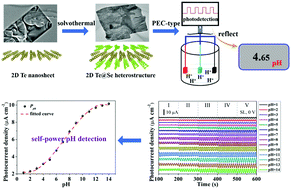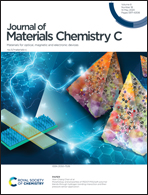Multifunctional VI–VI binary heterostructure-based self-powered pH-sensitive photo-detector†
Abstract
Two-dimensional (2D) mono-elemental materials from group IV–VI have aroused great interest in the scientific community on account of their intriguing optoelectronic properties. Integration of elements from the same group into binary hetero-structures is of great significance for their diversified properties and potential multifunctional applications. In this contribution, a 2D selenium (Se, VI) coated tellurium (Te, VI) nanosheet (NS) binary heterostructure (Te@Se) is constructed and demonstrated as a promising material for a photodetector (PD) in a photoelectrochemical (PEC)-type photodetection system. The experiments confirm that the Te@Se-based PD exhibits pH-sensitivity in a wide pH range from 1 to 14 with many other advantages such as self-powered, repeatable fast dynamic pH response, and long-term stability over 30 days. Theoretical calculations are performed to understand the mechanism of the pH-sensitive optoelectronic effects in 2D Te@Se in the framework of density functional theory (DFT) calculations. It is anticipated that the presented work expands a new concept for the applications of 2D binary heterostructure-based multifunctional devices, combining photo-detection and pH sensing.



 Please wait while we load your content...
Please wait while we load your content...